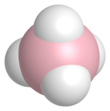Sodium borohydride

| |||
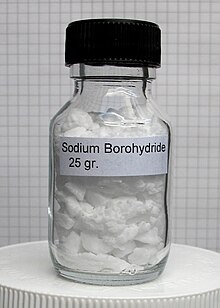
| |||
| |||
| Names | |||
|---|---|---|---|
| IUPAC name
Sodium tetrahydridoborate(1–)
| |||
| Systematic IUPAC name
Sodium boranuide | |||
| Identifiers | |||
| |||
3D model (JSmol)
|
|||
| ChEBI | |||
| ChemSpider | |||
| ECHA InfoCard | 100.037.262 | ||
| EC Number |
| ||
| 23167 | |||
| MeSH | Sodium+borohydride | ||
PubChem CID
|
|||
| RTECS number |
| ||
| UNII | |||
| UN number | 1426 | ||
CompTox Dashboard (EPA)
|
|||
| Properties | |||
| NaBH4 | |||
| Molar mass | 37.83 g/mol | ||
| Appearance | white crystals hygroscopic | ||
| Density | 1.07 g/cm3[1] | ||
| Melting point | 400 °C (752 °F; 673 K)(decomposes)[1] | ||
| 550 g/L[1] | |||
| Solubility | soluble in liquid ammonia, amines, pyridine | ||
| Structure[2] | |||
| Cubic (NaCl), cF8 | |||
| Fm3m, No. 225 | |||
a = 0.6157 nm
| |||
| Hazards | |||
GHS hazard statements
|
H260, H301, H311, H314 | ||
| P223, P231, P232, P280, P301+310, P370+378, P422 | |||
| NFPA 704 (fire diamond) | 
3
1
2 | ||
| Flash point | 70 °C (158 °F; 343 K) | ||
| ca. 220 °C (428 °F; 493 K) | |||
| Explosive limits | 3% | ||
| Lethal dose or concentration (LD, LC): | |||
LD50 (median dose)
|
160 mg/kg (Oral – Rat) 230 mg/kg (Dermal – Rabbit) | ||
| Related compounds | |||
Other anions
|
Sodium cyanoborohydride Sodium hydride Sodium borate Borax Sodium aluminum hydride | ||
Other cations
|
Lithium borohydride | ||
Related compounds
|
Lithium aluminium hydride Sodium triacetoxyborohydride | ||
Except where otherwise noted, data are given for materials in their standard state (at 25 °C [77 °F], 100 kPa). | |||
| Infobox references | |||
Sodium borohydride, also known as sodium tetrahydridoborate and sodium tetrahydroborate,[3] is an inorganic compound with the formula NaBH4. This white solid, usually encountered as a powder, is a reducing agent that finds application in chemistry, both in the laboratory and on an industrial scale. It has been tested as pretreatment for pulping of wood, but is too costly to be commercialized.[4][5] The compound is soluble in alcohols, certain ethers, and water, although it slowly hydrolyzes.[6]
The compound was discovered in the 1940s by H. I. Schlesinger, who led a team seeking volatile uranium compounds.[7][8] Results of this wartime research were declassified and published in 1953.
Properties[]
| Solvent | Solubility (g/100 mL)[6] |
|---|---|
| MeOH | 13 |
| EtOH | 3.16 |
| Diglyme | 5.15 |
| Et2O | insoluble |
Sodium borohydride is an odorless white to gray-white microcrystalline powder that often forms lumps. It can be purified by recrystallization from warm (50 °C) diglyme.[9] Sodium borohydride is soluble in protic solvents such as water and lower alcohols. It also reacts with these protic solvents to produce H2; however, these reactions are fairly slow. Complete decomposition of a methanol solution requires nearly 90 min at 20 °C.[10] It decomposes in neutral or acidic aqueous solutions, but is stable at pH 14.[6]
Structure[]
NaBH4 is a salt, consisting of the tetrahedral [BH4]− anion. The solid is known to exist as three polymorphs: α, β and γ. The stable phase at room temperature and pressure is α-NaBH4, which is cubic and adopts an NaCl-type structure, in the Fm3m space group. At a pressure of 6.3 GPa, the structure changes to the tetragonal β-NaBH4 (space group P421c) and at 8.9 GPa, the orthorhombic γ-NaBH4 (space group Pnma) becomes the most stable.[11][12][13]
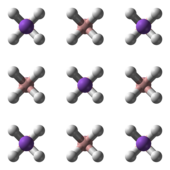 |
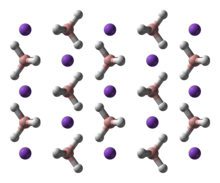 |
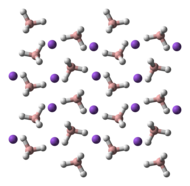 |
Synthesis and handling[]
For commercial NaBH4 production, the Brown-Schlesinger process and the Bayer process are the most popular methods. In the Brown-Schlesinger process sodium borohydride is industrially prepared from sodium hydride (produced by reacting Na and H2) and trimethyl borate at 250–270 °C:
- B(OCH3)3 + 4 NaH → NaBH4 + 3 NaOCH3
Millions of kilograms are produced annually, far exceeding the production levels of any other hydride reducing agent.[4] It can also be produced from inorganic borates, including borosilicate glass[14] and borax (Na2B4O7):
- Na2B4O7 + 16 Na + 8 H2 + 7 SiO2 → 4 NaBH4 + 7 Na2SiO3
Magnesium is a less expensive reductant, and could in principle be used instead:[15][16]
- 8 MgH2 + Na2B4O7 + Na2CO3 → 4 NaBH4 + 8 MgO + CO2
and
- 2 MgH2 + NaBO2 → NaBH4 + 2 MgO
Reactivity[]
Organic synthesis[]
NaBH4 reduces many organic carbonyls, depending on the precise conditions. Most typically, it is used in the laboratory for converting ketones and aldehydes to alcohols. It efficiently reduces acyl chlorides, anhydrides, α-hydroxylactones, thioesters, and imines at room temperature or below. It reduces esters slowly and inefficiently with excess reagent and/or elevated temperatures, while carboxylic acids and amides are not reduced at all.[17] NaBH4 reacts with water and alcohols, with evolution of hydrogen gas and formation of the corresponding borate, the reaction being especially fast at low pH.
Nevertheless, an alcohol, often methanol or ethanol, is generally the solvent of choice for sodium borohydride reductions of ketones and aldehydes. The mechanism of ketone and aldehyde reduction has been scrutinized by kinetic studies, and contrary to popular depictions in textbooks, the mechanism does not involve a 4-membered transition state like alkene hydroboration,[18] or a six-membered transition state involving a molecule of the alcohol solvent.[19] Hydrogen-bonding activation is required, as no reduction occurs in an aprotic solvent like diglyme. However, the rate order in alcohol is 1.5, while carbonyl compound and borohydride are both first order, suggesting a mechanism more complex than one involving a six-membered transition state that includes only a single alcohol molecule. It was suggested that the simultaneous activation of the carbonyl compound and borohydride occurs, via interaction with the alcohol and alkoxide ion, respectively, and that the reaction proceeds through an open transition state.[20][21]
α,β-Unsaturated ketones tend to be reduced by NaBH4 in a 1,4-sense, although mixtures are often formed. Addition of cerium chloride improves the selectivity for 1,2-reduction of unsaturated ketones (Luche reduction). α,β-Unsaturated esters also undergo 1,4-reduction in the presence of NaBH4.[6]
The NaBH4-MeOH system, formed by the addition of methanol to sodium borohydride in refluxing THF, reduces esters to the corresponding alcohols.[22] Mixing water or an alcohol with the borohydride converts some of it into unstable hydride ester, which is more efficient at reduction, but the reductant eventually decomposes spontaneously to produce hydrogen gas and borates. The same reaction can also occur intramolecularly: an α-ketoester converts into a diol, since the alcohol produced attacks the borohydride to produce an ester of the borohydride, which then reduces the neighboring ester.[23]
The reactivity of NaBH4 can be enhanced or augmented by a variety of compounds.[24][25]
Oxidation[]
Oxidation with iodine in tetrahydrofuran gives borane–tetrahydrofuran, which can reduce carboxylic acids.[26]
Partial oxidation of borohydride with iodine gives octahydrotriborate:[27]
- 3 BH4− + I2 → B3H8− + 2 H2 + 2 I−
Coordination chemistry[]
BH4− is a ligand for metal ions. Such borohydride complexes are often prepared by the action of NaBH4 (or the LiBH4) on the corresponding metal halide. One example is the titanocene derivative:[28]
- 2 (C5H5)2TiCl2 + 4 NaBH4 → 2 (C5H5)2TiBH4 + 4 NaCl + B2H6 + H2
Protonolysis and hydrolysis[]
In the presence of metal catalysts, sodium borohydride hydrolyzes with release of hydrogen. Exploiting this reactivity, sodium borohydride has been used in prototypes of the direct borohydride fuel cell.
- NaBH4 + 2 H2O → NaBO2 + 4 H2 (ΔH < 0)
Applications[]
The principal application of sodium borohydride is the production of sodium dithionite from sulfur dioxide: Sodium dithionite is used as a bleaching agent for wood pulp and in the dyeing industry.
Sodium borohydride reduces aldehydes and ketones to give the related alcohols. This reaction is used in the production of various antibiotics including chloramphenicol, dihydrostreptomycin, and thiophenicol. Various steroids and vitamin A are prepared using sodium borohydride in at least one step.[4]
Sodium borohydride has been considered as a solid state hydrogen storage candidate. Although practical temperatures and pressures for hydrogen storage have not been achieved, in 2012 a core–shell nanostructure of sodium borohydride was used successfully to store, release and reabsorb hydrogen under moderate conditions.[29]
Sodium borohydride can be used to reduce foxing in old books and documents.[30] This treatment should only be done by a skilled professional conservator/restorer as damage to paper can ensue if the reducing agent is not applied correctly, such as over bleaching and bubbling of paper.
Safety[]
Sodium borohydride is a source of hydrogen or diborane, which are both flammable. Spontaneous ignition can result from solution of sodium borohydride in dimethylformamide. Bulk solutions of sodium borohydride are often prepared with excess sodium hydroxide, which is corrosive.
See also[]
Many derivatives and analogues of sodium borohydride exhibit modified reactivity of value in organic synthesis.[31]
- Sodium triacetoxyborohydride, a milder reductant owing to the presence of more electron-withdrawing acetate in place of hydride.
- Sodium triethylborohydride, a stronger reductant owing to the presence of electron-donating ethyl groups in place of hydride.
- sodium cyanoborohydride, a milder reductant owing to the presence of more electron-withdrawing cyanide in place of hydride. Useful for reductive aminations.
- Lithium borohydride, a more strongly reducing reagent.
- L-selectride (lithium tri-sec-butylborohydride), a more strongly reducing are derivative.
- Lithium aluminium hydride, a more strongly reducing reagent, capable of reducing esters and amides.
References[]
- ^ Jump up to: a b c Haynes, William M., ed. (2011). CRC Handbook of Chemistry and Physics (92nd ed.). CRC Press. p. 4.89. ISBN 978-1439855119.
- ^ Ford, P. T. and Powell, H. M. (1954). "The unit cell of potassium borohydride, KBH4, at 90° K". Acta Crystallogr. 7 (8): 604–605. doi:10.1107/S0365110X54002034.CS1 maint: multiple names: authors list (link)
- ^ Busch, D.H. (2009). Inorganic Syntheses. 20. Wiley. p. 137. ISBN 9780470132869. Retrieved 20 May 2015.
- ^ Jump up to: a b c Rittmeyer, Peter; Wietelmann, Ulrich (2000). "Hydrides". Ullmann's Encyclopedia of Industrial Chemistry. Weinheim: Wiley-VCH. doi:10.1002/14356007.a13_199.
- ^ Istek, A. and Gonteki, E. (2009). "Utilization of sodium borohydride (NaBH4) in kraft pulping process" (PDF). Journal of Environmental Biology. 30 (6): 951–953. PMID 20329388.CS1 maint: multiple names: authors list (link)
- ^ Jump up to: a b c d Banfi, L.; Narisano, E.; Riva, R.; Stiasni, N.; Hiersemann, M. (2004). "Sodium Borohydride". Encyclopedia of Reagents for Organic Synthesis. New York: J. Wiley & Sons. doi:10.1002/047084289X.rs052. ISBN 978-0471936237.
- ^ Schlesinger, H. I.; Brown, H. C.; Abraham, B.; Bond, A. C.; Davidson, N.; Finholt, A. E.; Gilbreath, J. R.; Hoekstra, H.; Horvitz, L.; Hyde, E. K.; Katz, J. J.; Knight, J.; Lad, R. A.; Mayfield, D. L.; Rapp, L.; Ritter, D. M.; Schwartz, A. M.; Sheft, I.; Tuck, L. D.; Walker, A. O. (1953). "New developments in the chemistry of diborane and the borohydrides. General summary". J. Am. Chem. Soc. 75: 186–90. doi:10.1021/ja01097a049.
- ^ Hermann I Schlesinger and Herbert C Brown (1945) "Preparation of alkali metal compounds". US Patent 2461661. Granted on 1949-02-15; expired on 1966-02-15.
- ^ Brown, H. C. “Organic Syntheses via Boranes” John Wiley & Sons, Inc. New York: 1975. ISBN 0-471-11280-1. page 260-1.
- ^ Lo, Chih-ting F.; Karan, Kunal; Davis, Boyd R. (2007). "Kinetic Studies of Reaction between Sodium Borohydride and Methanol, Water, and Their Mixtures". Industrial & Engineering Chemistry Research. 46 (17): 5478–5484. doi:10.1021/ie0608861.
- ^ "Structural transitions in NaBH[sub 4] under pressure". Appl. Phys. Lett. 87 (26): 261916. 2005. doi:10.1063/1.2158505.
- ^ Filinchuk, Y.; Talyzin, A. V.; Chernyshov, D.; Dmitriev, V. (2007). "High-pressure phase of NaBH4: Crystal structure from synchrotron powder diffraction data". Phys. Rev. B. 76 (9): 092104. Bibcode:2007PhRvB..76i2104F. doi:10.1103/PhysRevB.76.092104. S2CID 122588719.
- ^ Kim, E.; Kumar, R.; Weck, P. F.; Cornelius, A. L.; Nicol, M.; Vogel, S. C.; Zhang, J.; Hartl, M.; Stowe, A. C.; Daemen, L.; Zhao, Y. (2007). "Pressure-driven phase transitions in NaBH4: theory and experiments". J. Phys. Chem. B. 111 (50): 13873–13876. doi:10.1021/jp709840w. PMID 18031032.
- ^ Schubert, F.; Lang, K.; Burger, A. (1960) "Alkali metal borohydrides" (Bayer). German patent DE 1088930 19600915 (ChemAbs: 55:120851). Supplement to. to Ger. 1,067,005 (CA 55, 11778i). From the abstract: "Alkali metal borosilicates are treated with alkali metal hydrides in approx. 1:1 ratio at >100 °C with or without H pressure"
- ^ Wu, Ying et al. (2004) Review of Chemical Processes for the Synthesis of Sodium Borohydride. Millennium Cell Inc.
- ^ Ouyang, Liuzhang; Zhong, Hao; Li, Hai-Wen; Zhu, Min (2018). "A Recycling Hydrogen Supply System of NaBH4 Based on a Facile Regeneration Process: A Review". Inorganics. 6: 10. doi:10.3390/inorganics6010010.
- ^ Banfi, Luca; Narisano, Enrica; Riva, Renata; Stiasni, Nikola; Hiersemann, Martin; Yamada, Tohru; Tsubo, Tatsuyuki (2014), "Sodium Borohydride", Encyclopedia of Reagents for Organic Synthesis, John Wiley & Sons, pp. 1–13, doi:10.1002/047084289x.rs052.pub3, ISBN 9780470842898
- ^ Carey, Francis A. (2016-01-07). Organic chemistry. Giuliano, Robert M., 1954– (Tenth ed.). New York, NY. ISBN 9780073511214. OCLC 915135847.
- ^ Loudon, Marc (2009). Organic chemistry (5th ed.). Greenwood Village, Colo.: Roberts and Co. ISBN 9780981519432. OCLC 263409353.
- ^ Wigfield, Donald C.; Gowland, Frederick W. (March 1977). "The kinetic role of hydroxylic solvent in the reduction of ketones by sodium borohydride. New proposals for mechanism, transition state geometry, and a comment on the origin of stereoselectivity". The Journal of Organic Chemistry. 42 (6): 1108–1109. doi:10.1021/jo00426a048.
- ^ Wigfield, Donald C. (January 1979). "Stereochemistry and mechanism of ketone reductions by hydride reagents". Tetrahedron. 35 (4): 449–462. doi:10.1016/0040-4020(79)80140-4. ISSN 0040-4020.
- ^ da Costa, Jorge C.S.; Pais, Karla C.; Fernandes, Elisa L.; de Oliveira, Pedro S. M.; Mendonça, Jorge S.; de Souza, Marcus V. N.; Peralta, Mônica A.; Vasconcelos, Thatyana R.A. (2006). "Simple reduction of ethyl, isopropyl and benzyl aromatic esters to alcohols using sodium borohydride-methanol system" (PDF). Arkivoc: 128–133. Retrieved 29 August 2006.
- ^ Dalla, V.; Catteau, J.P.; Pale, P. (1999). "Mechanistic rationale for the NaBH4 reduction of α-keto esters". Tetrahedron Letters. 40 (28): 5193–5196. doi:10.1016/S0040-4039(99)01006-0.
- ^ Periasamy, Mariappan; Thirumalaikumar, Muniappan (2000). "Methods of enhancement of reactivity and selectivity of sodium borohydride for applications in organic synthesis". Journal of Organometallic Chemistry. 609 (1–2): 137–151. doi:10.1016/S0022-328X(00)00210-2.
- ^ Nora de Souza, Marcus Vinícius; Alves Vasconcelos; Thatyana Rocha (1 November 2006). "Recent methodologies mediated by sodium borohydride in the reduction of different classes of compounds". Applied Organometallic Chemistry. 20 (11): 798–810. doi:10.1002/aoc.1137.
- ^ Kanth, J. V. Bhaskar; Periasamy, Mariappan (1 September 1991). "Selective reduction of carboxylic acids into alcohols using sodium borohydride and iodine". The Journal of Organic Chemistry. 56 (20): 5964–5965. doi:10.1021/jo00020a052.
- ^ Ryschlewitsch, G. E.; Nainan, K. C. (1974). "Octahydrotriborate (1-) ([B3 H8 ]) salts". Inorganic Syntheses. 15: 111–118. doi:10.1002/9780470132463.ch25. ISBN 9780470132463.
- ^ Lucas, C. R. (1977). Bis(5-Cyclopentadienyl) [Tetrahydroborato(1-)]Titanium. Inorganic Syntheses. 17. p. 93. doi:10.1002/9780470132487.ch27. ISBN 9780470132487.
- ^ Stuart Gary, "Hydrogen storage no longer up in the air" in ABC Science 16 August 2012, citing Christian, Meganne; Aguey-Zinsou, Kondo François (2012). "Core–Shell Strategy Leading to High Reversible Hydrogen Storage Capacity for NaBH4". ACS Nano. 6 (9): 7739–7751. doi:10.1021/nn3030018. PMID 22873406.
- ^ Masters, Kristin. "How to Prevent and Reverse Foxing in Rare Books". bookstellyouwhy.com. Retrieved 3 April 2018.
- ^ Seyden-Penne, J. (1991) Reductions by the Alumino- and Borohydrides in Organic Synthesis. VCH–Lavoisier: Paris. p. 9. ISBN 978-0-471-19036-3
External links[]
- Sodium compounds
- Borohydrides
- Reducing agents


